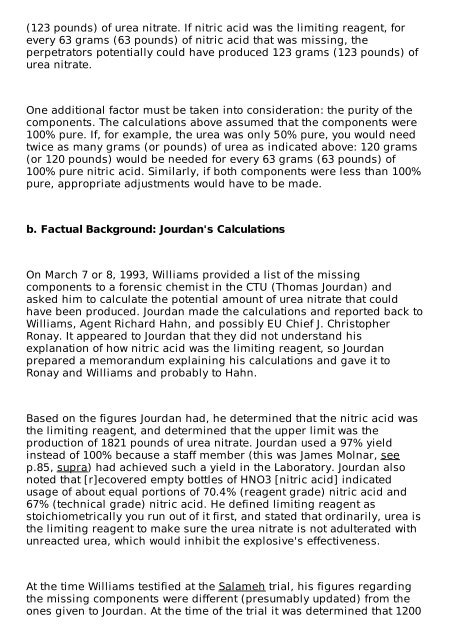linked - Investigating the Terror
linked - Investigating the Terror
linked - Investigating the Terror
Create successful ePaper yourself
Turn your PDF publications into a flip-book with our unique Google optimized e-Paper software.
(123 pounds) of urea nitrate. If nitric acid was <strong>the</strong> limiting reagent, for<br />
every 63 grams (63 pounds) of nitric acid that was missing, <strong>the</strong><br />
perpetrators potentially could have produced 123 grams (123 pounds) of<br />
urea nitrate.<br />
One additional factor must be taken into consideration: <strong>the</strong> purity of <strong>the</strong><br />
components. The calculations above assumed that <strong>the</strong> components were<br />
100% pure. If, for example, <strong>the</strong> urea was only 50% pure, you would need<br />
twice as many grams (or pounds) of urea as indicated above: 120 grams<br />
(or 120 pounds) would be needed for every 63 grams (63 pounds) of<br />
100% pure nitric acid. Similarly, if both components were less than 100%<br />
pure, appropriate adjustments would have to be made.<br />
b. Factual Background: Jourdan's Calculations<br />
On March 7 or 8, 1993, Williams provided a list of <strong>the</strong> missing<br />
components to a forensic chemist in <strong>the</strong> CTU (Thomas Jourdan) and<br />
asked him to calculate <strong>the</strong> potential amount of urea nitrate that could<br />
have been produced. Jourdan made <strong>the</strong> calculations and reported back to<br />
Williams, Agent Richard Hahn, and possibly EU Chief J. Christopher<br />
Ronay. It appeared to Jourdan that <strong>the</strong>y did not understand his<br />
explanation of how nitric acid was <strong>the</strong> limiting reagent, so Jourdan<br />
prepared a memorandum explaining his calculations and gave it to<br />
Ronay and Williams and probably to Hahn.<br />
Based on <strong>the</strong> figures Jourdan had, he determined that <strong>the</strong> nitric acid was<br />
<strong>the</strong> limiting reagent, and determined that <strong>the</strong> upper limit was <strong>the</strong><br />
production of 1821 pounds of urea nitrate. Jourdan used a 97% yield<br />
instead of 100% because a staff member (this was James Molnar, see<br />
p.85, supra) had achieved such a yield in <strong>the</strong> Laboratory. Jourdan also<br />
noted that [r]ecovered empty bottles of HNO3 [nitric acid] indicated<br />
usage of about equal portions of 70.4% (reagent grade) nitric acid and<br />
67% (technical grade) nitric acid. He defined limiting reagent as<br />
stoichiometrically you run out of it first, and stated that ordinarily, urea is<br />
<strong>the</strong> limiting reagent to make sure <strong>the</strong> urea nitrate is not adulterated with<br />
unreacted urea, which would inhibit <strong>the</strong> explosive's effectiveness.<br />
At <strong>the</strong> time Williams testified at <strong>the</strong> Salameh trial, his figures regarding<br />
<strong>the</strong> missing components were different (presumably updated) from <strong>the</strong><br />
ones given to Jourdan. At <strong>the</strong> time of <strong>the</strong> trial it was determined that 1200


